Reserve Bank Bulletin – February 1998 The Economy and Financial Markets
Download the complete Statement 245KB
Introduction
The Australian economy experienced a significant pick-up in growth in 1997, after a slower year in 1996. The pick-up was led mainly by stronger domestic demand, with a cyclical upswing in the housing sector getting under way and a firmer trend in consumer demand. By year's end, the labour market had improved, such that employment and labour force participation were rising, and unemployment was beginning to decline.
These developments were helped by the fact that monetary policy had been eased progressively through the second half of 1996, and again in the middle of 1997, a process which brought some interest rates to their lowest levels since the late 1960s. This easing was possible because of the good inflation performance, which in turn was due in almost equal measure to a decline in prices for internationally traded goods and services and a slowing in the pace of growth of domestic costs. Annual underlying inflation ended the year at 1.4 per cent.
Early indications are that buoyant growth in private demand is continuing in 1998. The improvement in labour market conditions should mean that household income growth will be adequate to sustain the current trend in consumption, and the housing sector upswing still has some way to run, as does the pick-up in other types of construction.
At the same time that this favourable domestic news has been coming through, economic conditions in the Asian region have continued to deteriorate. Since the Bank's last Semi-Annual Statement in November, Korea became the third country to call for IMF assistance after experiencing financial difficulties in the closing months of 1997. Asian banking systems have come under pressure from falling currencies and stock markets. Although many Asian economies have steadied since the beginning of 1998, the value of the Indonesian rupiah has halved so that it is now only a quarter of its value in mid 1997. Given Australian exporters' exposure to the region, markets have also pushed down the Australian dollar against the major world currencies.
A number of the Asian economies are now entering a period of economic contraction, and considerably higher inflation as a result of the very large currency depreciations. Even in countries where growth will continue, it is likely to be at a significantly reduced pace. Japan, the region's largest economy, has again recorded a stagnant performance over recent months. This is partly because of tax increases last April, but a deeper problem for the Japanese economy is the lingering fragility in the banking system, a problem aggravated by Japan's financial exposures to other Asian markets.
In themselves, these developments make the outlook for exporters considerably more difficult, even though export performance over the last year has been quite strong. Exporters will, however, be assisted in many instances by recent developments in the exchange rate, which has depreciated substantially against currencies from outside the region. This should help competitiveness into European and North American markets, which are continuing to grow, and also help Australian exporters to compete with those from countries outside the region in sales into Asia. This should provide some partial offset to the direct impact of the Asian slump. In addition, while commodity prices measured in foreign currency terms have fallen, the decline in the exchange rate has in most cases more than offset this, so that in $A terms, prices have tended to rise over the past year.
Overall, some reduction in export growth during 1998 is to be expected, although the full effects might not emerge quickly. These trends will act to slow growth in the Australian economy from the rate it would otherwise have been. On present indications, however, there is enough momentum in domestic demand to achieve a reasonable pace of overall growth. The divergence between domestic demand and external circumstances means that the current account deficit will widen further.
Monetary policy remains conducive to domestic expansion: interest rates are relatively low, and credit is growing strongly. The exchange rate has fluctuated considerably in bilateral terms and will have diverse effects on different parts of the economy. At current levels, the import-weighted exchange rate is close to its average level of the past year and will have little net impact on the trend in import prices, but the downward impetus to import prices working over the past year has been removed. The Bank's current expectation is that underlying inflation will gradually move up towards the target over the year ahead.
Monetary policy will be directed towards the continuance of the low-inflation expansion that the economy has experienced since the early 1990s. In this, it will be assisted by the fact that the economy is entering what could be a difficult year in good shape, with output growing at 4 per cent plus and low inflation. In the period ahead, the pursuit of these medium-term objectives will require policy to place a good deal of importance on fostering financial market stability. Australia has done well to avoid the worst of the financial turmoil that has characterised our region over the past 12 months – continuing to do so must be a high priority.
Financial Market Developments
The turmoil in East Asian financial markets intensified in the closing months of 1997 and into early 1998, with periods of extreme instability in several countries. The escalation of the disturbance was first evident in its spread from the ASEAN economies to South Korea, the region's second largest economy, and then by renewed pressure on Indonesia in January. In a number of countries, but particularly in Indonesia, exchange rates have now fallen to levels that seem impossible to justify on economic criteria. Developments in Japan added to the gloom across the Asian region, as further failures in the Japanese financial system came to light and the economy continued to disappoint.
The turmoil in Asia also had a significant impact on markets in developed countries. The US dollar appreciated, bond yields in the US and elsewhere generally fell and share markets fell sharply in October before gradually recovering over the following months. These developments reflected ‘safe-haven’ buying of US dollars and bonds, and talk, to an extent exaggerated, of possible deflationary influences beginning to operate in goods markets as a result of developments in Asia. Commodity prices, including prices for gold, oil and base metals, fell quite sharply in some cases when measured in US dollars, although less so when measured in other currencies.
In the case of Australia, bond yields and share prices have broadly moved in line with those in the US – i.e. bond yields have fallen and the share market has moved higher, hesitantly, after the drop in October. In the case of the exchange rate, pessimism about commodity prices and the potential consequences of reduced trade with Asia saw the Australian dollar move lower against the US dollar. Needless to say, it was stronger against the currencies of major trading partners in Asia. As discussed in the article Alternative Measures of the Effects of Exchange Rate Movements on Competitiveness, published in the January Bulletin, these divergent trends should be interpreted carefully.
Asian financial markets
After the sharp falls in the September quarter, it looked for a time in October that the exchange rates of the ASEAN-4 (Thailand, Indonesia, the Philippines and Malaysia) had begun to steady. IMF support programs for Thailand – which had already been put in place – and for Indonesia, which was well advanced, helped calm investors in these markets.
As was reported in the Bank's November Semi-Annual Statement on Monetary Policy, however, this turned out to be a false dawn. The disturbance entered a new, and ultimately more serious, phase later in October when Taiwan devalued its currency in an effort to recoup losses in its competitiveness from the large depreciations of the currencies of the ASEAN-4. In reaction to this, pressures built on other countries of North Asia which had been holding the line on their exchange rates. A particular market focus was the viability of the peg of the Hong Kong dollar to the US dollar. Authorities in Hong Kong responded successfully to this test with a combination of strong foreign exchange intervention and large rises in interest rates.
A similar line of defence in South Korea failed to contain exchange rate pressures. The country was more susceptible to an adverse financial shock because economic growth had slowed and Korean companies and banks had built up high levels of foreign debt, much of it short term. As the exchange rate and share prices fell, these weaknesses were exposed. Many Korean companies and banks found it increasingly difficult to raise sufficient foreign exchange to repay foreign-currency debt as it fell due, with the resulting uncertainty accentuating pressure on the exchange rate. By early December, foreign exchange reserves had been heavily depleted and the Korean authorities sought assistance from the IMF.
While this provided some temporary relief to exchange pressures, the approach of presidential elections, and a lengthy handover period to the new administration, delayed decisive policy action, including settlement of conditions with the IMF. This meant that, although the IMF-led support package was the largest in history (US$59 billion, of which Australia will contribute US$1 billion), the won fell heavily again for a time. Some stability was achieved after it was announced that private banks in many countries were rolling over maturing obligations of South Korean banks, and that donor countries participating in the IMF package would accelerate their bilateral assistance. By late January, the won had settled around a level 40 per cent lower than in July 1997.
While the Korean exchange rate began to settle in January, the Indonesian currency fell sharply as doubts grew about that country's capacity to comply with the terms of its IMF package. Political circumstances including reports of the President's ill health were partly responsible, as was suspicion that the Indonesian budget did not comply with IMF guidelines. At one stage, the rupiah fell to an intra-day low of almost 17,000 to the US dollar, compared with about 2500 in mid 1997. It has since recovered somewhat, but remains down by around 75 per cent. This experience was well beyond that of other currencies in the region. Over the same period, the exchange rates of Thailand and Malaysia fell by around 45 per cent, the Philippines' peso was down by 36 per cent and the Taiwan and Singapore dollars by about 17 per cent (Graphs 1 and 2). The currencies of China and Hong Kong have remained steady throughout the episode.
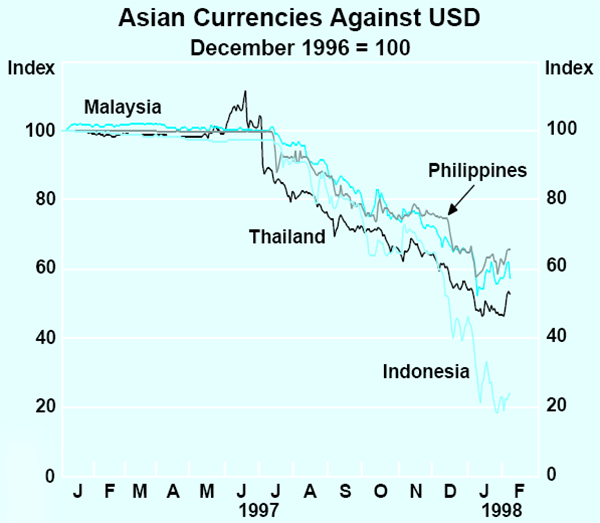
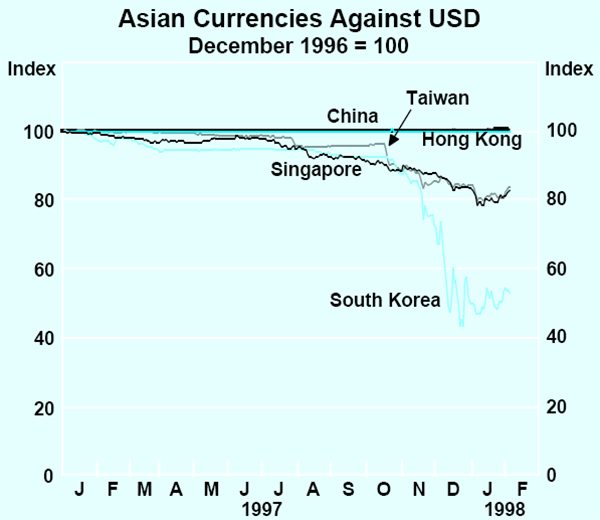
All stock markets in Asia declined significantly in the second half of 1997. Falls of 40–50 per cent are common around the region, and are larger, of course, in US dollar terms. More recently, some of the markets have recovered somewhat. Movements in Asian share markets are summarised in Table 1.
| 1 January 1997 | 2 July 1997 | 1 January 1998 | |
|---|---|---|---|
| Thailand | −36 | −6 | 43 |
| Indonesia | −19 | −30 | 28 |
| Philippines | −35 | −26 | 10 |
| Malaysia | −42 | −34 | 20 |
| Hong Kong | −22 | −31 | −3 |
| Taiwan | 24 | −4 | 5 |
| Singapore | −33 | −24 | −3 |
| South Korea | −19 | −32 | 40 |
| China | 36 | 3 | 3 |
Efforts to stabilise exchange rates around Asia have involved higher short-term interest rates (Graph 3). In the three countries receiving support from the IMF, short-term interest rates have increased by more than 10 percentage points from their levels in the first half of 1997. While the higher structure of short-term interest rates across Asia should eventually help stabilise capital flows and relevant exchange rates, they are also likely to restrain growth in domestic spending and possibly add to deflationary pressures in asset markets in the countries concerned.
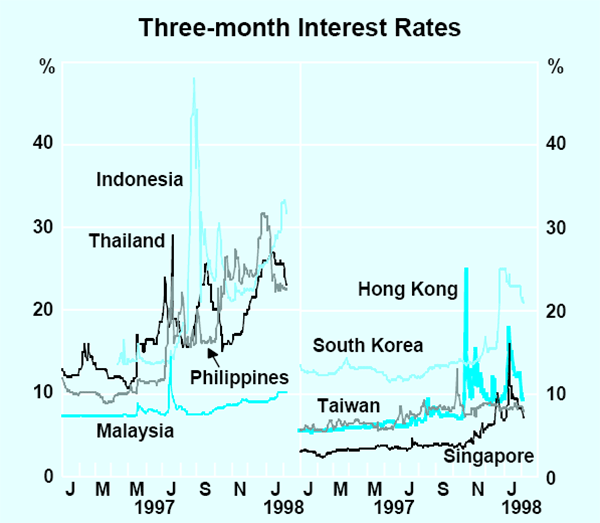
Financial markets in industrial countries
The deterioration in the Japanese economy and the evident strains in the financial system saw confidence fall to a low ebb in financial markets there. The most pronounced adjustment was in the stock market, where the Nikkei index fell to under 15,000 in December, a level last seen in the recession of 1995. Announcement of a fiscal package designed to stimulate the economy initially failed to revive the stock market, where sentiment continued to mirror concern about the stability of the financial system. Subsequently, however, rumours that the authorities may undertake further measures helped the market to recover to about 17,000 by late January. This was, nonetheless, still almost 20 per cent down from mid 1997.
With weakness on the stock exchange, and perceptions that Japan might be moving toward a phase of deflation, demand for Japanese bonds remained strong. The yield on 10-year bonds rallied from the already low level of 2.5 per cent in June 1997, to new historical lows of about 1.6 per cent by November, before settling around 1.8 per cent.
The stance of Japanese monetary policy has remained unchanged in recent months, with the call money rate around 0.5 per cent. Despite this, there has been some rise in Japanese banks' cost of funds, reflecting a widening in risk premia. At the short end of the yield curve, yields on three-month euro-yen securities rose by about 50 basis points, to 1 per cent. The premium on foreign currency raisings by Japanese banks increased even further.
Weakness in Asia had its counterpoint in strengthening US markets: the US dollar rose against all major currencies and US bond yields moved to new lows. Underpinning the strength of the US bond market is the continuing run of improving inflation news – both producer and consumer prices – and growing confidence that this would continue without the Fed having to act to slow the US economy. The inflation-restraining influence of Asian developments, especially in goods markets, gave the rally in bonds further support, with the yield on 10-year US Treasuries falling to an intra-day low of 5.3 per cent, their lowest level since 1993. Bond yields also rallied in other major industrial countries. In Germany, for example, yields also moved to a new cyclical low of 5.0 per cent.
The rise in the US dollar in recent months is a continuation of a trend that began in mid 1995. Since then, the US dollar has appreciated in trade-weighted terms by about 20 per cent (Graph 4). This appreciation reflects the health of the US economy relative to that of other major countries, reinforced in recent months by strong ‘safe-haven’ buying following the turbulence in Asia.
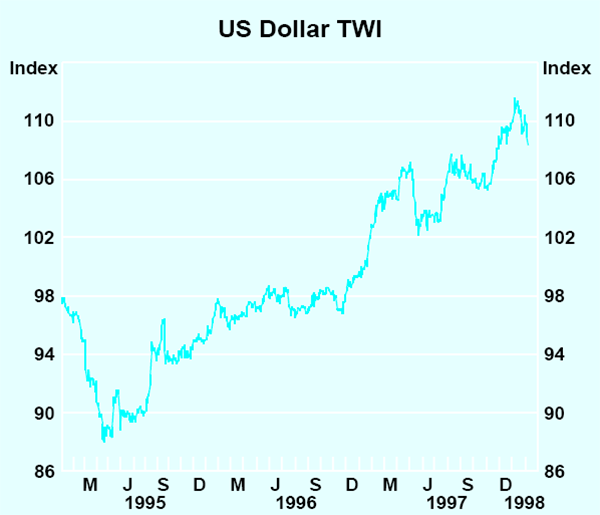
The rise in the US dollar is consistent with desirable adjustments in the world economy at this stage, since it will help spill strong growth in domestic demand in the United States over to economies with excess productive capacity, especially in Asia, including Japan. In the process, it will also help limit inflationary pressures in the United States, thereby possibly delaying any need to tighten monetary policy. After the tightening in March 1997, which lifted the Fed funds rate by 0.25 percentage points to 5.5 per cent, the Fed has left interest rates unchanged. This was against a background of continuing good inflation outcomes, notwithstanding the strength of demand and the tightening of the labour market. However, interest rates have been increased in the UK, several other European countries, Canada and New Zealand in recent months. In the case of the latter two countries, some of the rise was in response to softness in exchange rates (Graph 5).
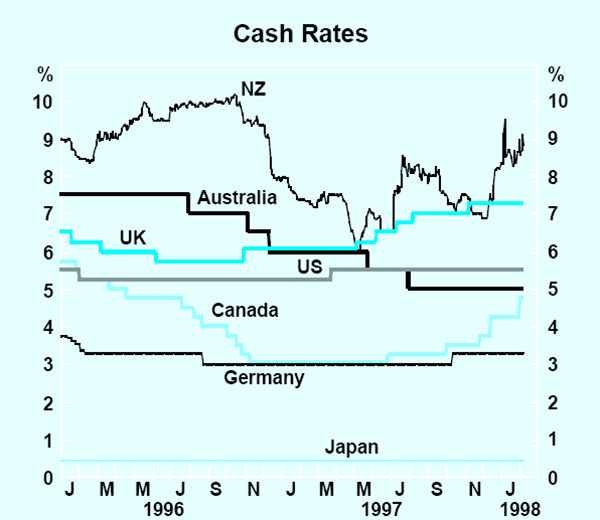
Australian financial markets
The Australian dollar has moved lower against the US dollar. In early January, it reached a low of US63.20 cents before intervention by the Bank lifted the rate above US64 cents. Thereafter, more settled conditions in Asia, a recovery in the price of gold and comments by some investment banks to the effect that the local currency had been significantly undervalued against the US dollar also boosted sentiment. By early February, the Australian dollar had risen to around US68 cents (Graph 6).
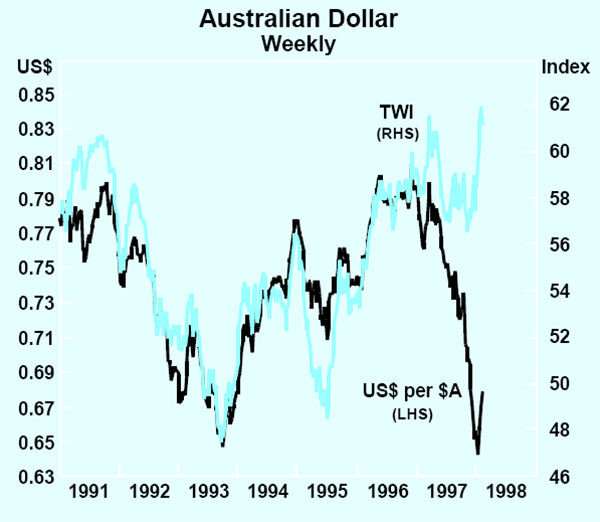
Over the past year or so, the Australian dollar has depreciated by about 15 per cent against the US dollar. At the same time, it has appreciated very strongly against the currencies of a number of major trading partners in Asia. The net result of weakness against the US dollar and strength against currencies of trading partners in Asia was that the trade-weighted index of the Australian dollar has increased in recent months to as high as 62, a level slightly above that reached in early 1997.
As was explained in the article Alternative Measures of the Effects of Exchange Rate Movements on Competitiveness, published in the January Bulletin, the contrasting influences on the Australian dollar, resulting from the strong US dollar and weak Asian currencies, mean that the trade-weighted index is currently providing a somewhat misleading picture of overall exchange rate developments. The Bank's view is that this combination of movements in bilateral rates, for an unchanged TWI, would tend to have a moderately expansionary net effect on prices and economic activity in Australia, although the effects are not evenly distributed through the economy.
A number of factors have contributed to the decline in the Australian dollar against the US dollar. As discussed, with the US dollar rising against all currencies, some depreciation of the Australian dollar in US dollar terms was inevitable and desirable. Additionally, financial markets were aware that the deterioration in Asia will make the trading climate more difficult for Australian exporters, with some increase in Australia's current account deficit likely. A related concern is that excess capacity in Asian economies might contribute to deflationary forces, at least in some goods markets. These influences on the Australian dollar occurred against a backdrop of relatively low domestic interest rates and narrow interest differentials against other countries.
In recent months, the Bank has undertaken some modest intervention in the foreign exchange market at times when markets were unsettled, or when the fall in the exchange rate risked becoming self-reinforcing. In doing so, it has not sought to prevent a sensible adjustment in the exchange rate to reflect the deterioration in Australia's international trading climate. This intervention was the first such exercise since November 1993. Since October, Reserve Bank purchases of Australian dollars have amounted to $400 million, of which $100 million was undertaken in January.
With no change in monetary policy in recent months, the main influence on short-term interest rates in Australia was the run of economic news, which pointed to healthy economic growth. Expectations of a further cut in the cash rate were dispelled by mid November. Short-term interest rates rose as a result, with the yield on 90-day bank bills rising by 0.25 of a percentage point to around 5 per cent, the level of the cash rate (Graph 7).
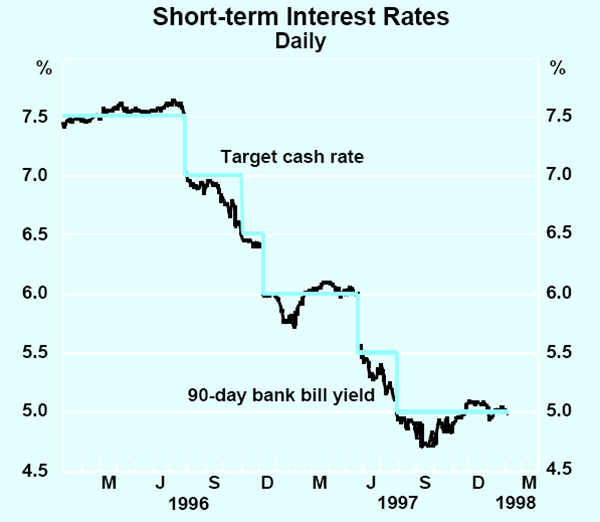
As expectations of a further cut in the cash rate subsided, bond yields also rose for a period. Between late November and early December, they moved up by 0.5 of a percentage point to near 6.4 per cent. As bond yields in the United States then rallied, however, the yield on 10-year bonds in Australia also fell, and by early January had reached around 5.6 per cent, its lowest level since May 1969 (Graph 8). In those days, low interest rates were set by the authorities and the demand for bonds by financial institutions was artificially boosted by ‘captive’ arrangements which forced them to maintain a set ratio of bonds to total assets. The major factor in recent moves in Australia, as abroad, was a consensus that events in Asia would probably have a disinflationary effect. The spread to the yields in the United States also moved up from the historical low, of virtually zero early in November, to around 40 points at present (Graph 9).
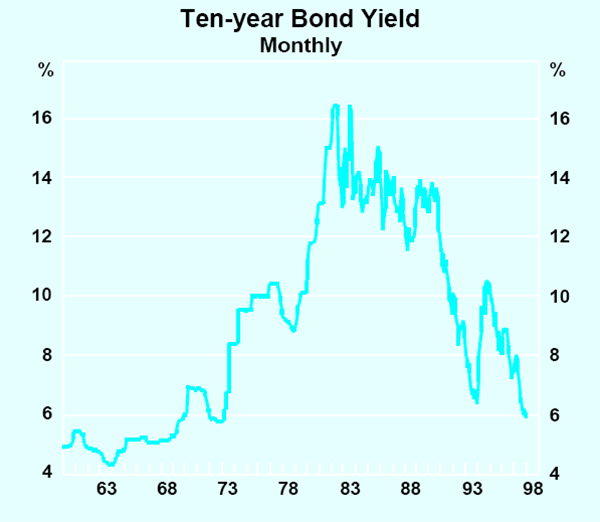
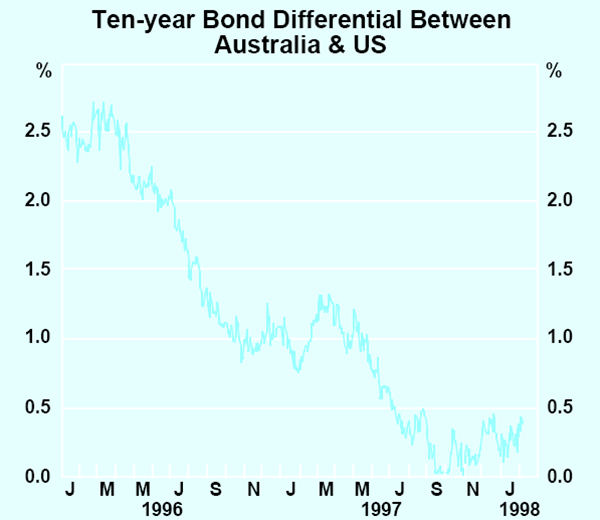
International Economic Conditions
Demand and activity in East Asia
In the wake of the recent financial instability most expectations are that growth in the East Asian region will decline significantly over the next year or two, with contractions in some countries. Thailand, Indonesia and Korea are likely to be in this latter group – showing a sharp contrast to the growth rates of 6 to 8 per cent that had been typical earlier in the decade. Elsewhere in the region, the effects on growth are generally expected to be smaller, although still sizeable.
There are several forces at work contributing to the weaker growth outlook. Part of the background to the financial instability described earlier was an extended period of strong credit growth which supported inflated asset prices, excessive investment in property development and surplus industrial capacity in a number of industries. With this cycle now having turned down, economies are experiencing a period of adjustment in which surplus capacity has to be absorbed and debt burdens reduced to more manageable levels. The experience of other countries, including developed economies, which have undergone this sort of financial adjustment in the past, has been that the process can take some time to work through, and involves a sharp contraction in economic activity and declining asset prices. The adjustment problem is compounded by difficulties in financial institutions and by continuing high interest rates in some countries, aimed at resisting further downward pressures on exchange rates.
These forces operating to restrain domestic demand will to some extent be offset by the boost to exports coming from exchange rate depreciations. By any standard, the depreciations that have taken place in the currencies of the ASEAN-4 economies and Korea will make their exports highly competitive on world markets, and should help export-oriented businesses to rebuild their profit margins. On the other hand, there has been little change in competitiveness for Singapore and Taiwan, while China and Hong Kong have lost competitiveness vis-a-vis other countries in the region. To some extent, also, the gains in competitiveness of the countries with depreciating currencies will be offset over time by the higher inflation which is already becoming evident.
It will be some time before confident judgments can be made about the overall impact of these forces, partly because the financial market developments are still unfolding. Nonetheless, indicators becoming available in the past few months have shown the beginnings of the effects of the financial instability on trade and economic activity in the region (Table 2). The effects are clearest in the case of Thailand, where the level of industrial production began to fall in mid 1997 after a period of growth averaging around 10 per cent over the previous two years; by November, Thai industrial production was 15 per cent below the level of a year earlier. Following the currency depreciation, the Thai trade account has moved into surplus, largely through a sharp decline in imports. Exports in US dollar terms have been relatively flat, but this probably implies some growth in volume terms, as baht depreciation allows Thai producers to lower their US dollar selling prices.
| Industrial production | Imports (US$) | Exports (US$) | |||||||||
|---|---|---|---|---|---|---|---|---|---|---|---|
| 1995 | 1996 | Latest 3 months |
1995 | 1996 | Latest 3 months |
1995 | 1996 | Latest 3 months |
|||
| Thailand | 11.0 | 8.0 | −11.4 | 30.0 | 2.2 | −24.3 | 24.7 | −1.3 | 5.3 | ||
| Indonesia | 10.8 | 6.6 | 9.0 | 27.0 | 5.6 | −5.8 | 13.4 | 8.3 | 7.1 | ||
| Philippines | 16.5 | 5.6 | 9.0 | 26.7 | 22.2 | 11.6 | 29.3 | 18.3 | 24.2 | ||
| Malaysia | 13.9 | 10.9 | 9.6 | 30.7 | 1.0 | −5.2 | 26.0 | 5.6 | −1.3 | ||
| South Korea | 11.9 | 8.5 | 6.3 | 32.0 | 11.3 | −19.4 | 30.3 | 3.7 | 3.3 | ||
| Hong Kong | 1.0 | −3.7 | 0.5 | 20.1 | 3.0 | 4.7 | 14.8 | 4.0 | 5.3 | ||
| Taiwan | 4.2 | 1.8 | 8.3 | 21.3 | −1.1 | 11.9 | 20.0 | 3.8 | 6.5 | ||
| Singapore | 10.4 | 3.3 | 10.2 | 21.3 | 5.5 | −5.1 | 22.1 | 5.7 | −3.9 | ||
| China | 13.5 | 13.2 | 11.5 | 14.2 | 5.2 | −13.1 | 23.1 | 1.6 | 14.3 | ||
| Japan | 3.5 | 2.7 | −0.4 | 23.3 | 6.9 | −7.6 | 11.1 | −6.3 | 2.4 | ||
|
Sources: National statistics |
|||||||||||
Elsewhere in the region there are also signs of weaker import demand in some countries, particularly in Korea, Indonesia and Malaysia, where imports have been declining in US dollar terms for several months. Industrial production has so far continued to grow solidly in most countries, possibly reflecting the resilience of exports.
Japan
The Japanese economy continues to struggle, with confidence having been set back by the developments elsewhere in Asia. Following the 2.8 per cent fall in the June quarter, output had been expected to rebound solidly in the September quarter. In the event, it expanded by only 0.8 per cent in the quarter, to be up 1.0 per cent over the year. More recent indicators continue to suggest a weaker-than-expected recovery, which has led to a sharp downgrading in forecasts of output growth in 1998. Consumer confidence is low, the unemployment rate remains around its record high of 3.5 per cent, and banks are imposing tougher credit constraints on borrowers. External demand had been providing some stimulus to the domestic economy on the back of a significant depreciation of the yen since 1995; the prospects of it continuing to do so have been dimmed by the mounting economic problems in the rest of Asia, which is Japan's largest export market.
The latest Tankan survey confirms businesses' pessimism about the economy's near-term prospects. Financial fragility continues to hamper the recovery; official estimates of bad and doubtful loans held by Japanese banks are now estimated to have reached 12 per cent of total loans. A number of fiscal stimulus packages have been announced in recent months, including a one-off ¥2 trillion (0.4 per cent of GDP) personal income tax cut. The government has also approved the use of public funds to stabilise the financial system, with ¥17 trillion being allocated for protection of deposits and ¥13 trillion for the purchase of the shares and debt of troubled banks.
United States and Europe
Despite a natural tendency to concentrate on Asia, developments in the United States and Europe remain important to an overall assessment of Australia's external environment. The United States and European economies together make up a larger part of world demand than Asia does, and they have the dominant bearing on the outlook for commodity prices. In addition, history has shown that economic activity in the United States has generally had an influence on the Australian business cycle out of proportion to the direct trade links between the two countries. The continuing health of the United States and European economies should therefore help to mitigate, to some extent, the effects on Australia of the economic problems in Asia.
The United States economy continues to enjoy a remarkable conjunction of strong growth and low inflation. During 1997, the seventh year of economic expansion, output grew by 3.9 per cent. This added 3.2 million jobs to payrolls, bringing the unemployment rate down to 4.7 per cent, below most estimates of the rate consistent with steady inflation. Despite this, earnings growth has picked up only modestly, with average hourly earnings rising by 3.7 per cent, and the employment cost index, a broader measure of labour costs, up by 3.3 per cent over the year. Core producer prices were essentially unchanged over the year and the exchange rate appreciated, which, together with refinements to the measurement of consumer prices, helped to deliver a rise of only 2.2 per cent in core consumer prices over 1997. The continuation of strong growth combined with minimal inflation pressures has led gradually to an upgrading of output growth forecasts for 1998.
Stronger growth in the major continental European economies is reducing the difference in performance between them and a periphery of faster-growing economies. In Germany, a gradual recovery is continuing, although net foreign trade continues to provide a disproportionate share of this growth. In France and Italy, there are clearer signs of strengthening domestic demand. Price pressures remain muted in all three economies, but economic growth is not yet sufficiently robust to make significant inroads into the record levels of unemployment. After estimated growth of 2.5 per cent in 1997, forecasters had been becoming more optimistic about Western European growth in 1998. Although recent events in Asia have led to a minor scaling back of these forecasts, a modest pick-up in growth is still expected this year.
Domestic Economic Activity
Real output is likely to have expanded by around 4 per cent, or possibly a little faster, through 1997, compared with growth of 2.4 per cent through 1996. This strengthening owes a good deal to a marked pick-up in private consumption, usually a component of demand that displays little variability in growth. The dwelling sector continues to contribute to growth, driven by historically high levels of housing affordability, although the upturn is more moderate than usual because of lingering pockets of over-supply, arising from the previous cycle. Business investment remains a major driver of the expansion, with the recent strength being contributed by equipment investment, rather than spending on buildings and structures. The quantity of exports has displayed good growth through 1997, while strong growth in imports over the same period confirms the strength of domestic demand.
The strengthening in domestic activity through 1997 brought forth a solid lift in employment in the second half of the year, with most of the strength in full-time employment. With the rise in the demand for labour, unemployment has begun to fall, and people are being encouraged back into the labour force.
Household income and expenditure
The national accounts measure of private consumption grew strongly in the June and September quarters, following an extended period of sluggishness. The earlier weakness was concentrated in retail trade, which makes up 40 per cent of private consumption. Sales at department stores and clothing retailers were particularly weak in the first half of 1997 as consumers postponed discretionary spending. By contrast, other components of consumption maintained good, steady growth, as most of them have since the beginning of the 1990s. The strengthening in retail trade, which began in mid year, was led by a resurgence in spending at department stores, but has otherwise been reasonably broadly based. Motor vehicle sales have been particularly strong, rising by around 20 per cent over the past year. Monthly retail sales and motor vehicle sales data suggest that consumption remained at a high level in the December quarter. While retail sales data recorded a decline in the month of December, an increasing tendency for spending to be delayed until January over recent years has meant that December data usually need to be taken with results for January in order to gauge the strength of demand.
The strengthening of private consumption has been supported by steady growth in household incomes, and by declines in interest rates, which have benefited the nearly 30 per cent of households with home loans. Spending by consumers may also have been encouraged by improved employment prospects in the second half of the year (Graph 10).
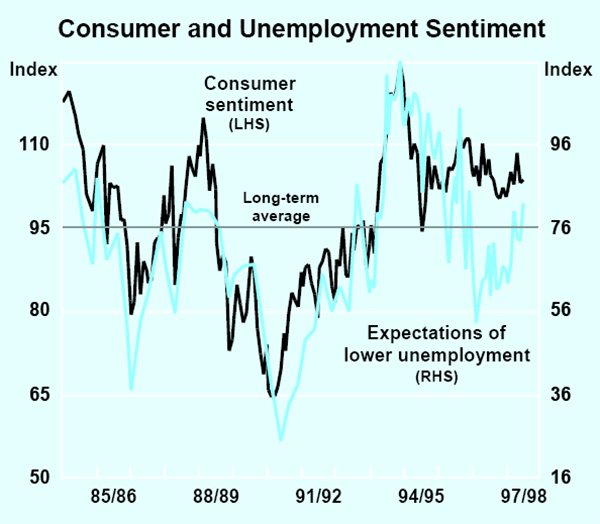
Consumer sentiment, as measured by the Westpac-Melbourne Institute survey, remains clearly above its longer-term average, but has changed little over the past year. Over the last few months, consumers' expectations of their own economic prospects for the year ahead have improved gradually, while their assessment of the outlook for the economy has deteriorated. This may suggest that, while aware of the emergence of serious economic problems in Asia, consumers have been more influenced by strengthening domestic economic conditions when assessing their own prospects.
The reduction in home-loan interest rates – due both to declines in official interest rates and a narrowing of margins in the home-loan market as competition intensified – has driven housing affordability to its current extremely high level, and has underpinned the gradual expansion in dwelling investment. That this pick-up has not been stronger is due to the higher-than-usual excess supply of dwellings in the outer suburbs of most capital cities and in regional Australia.
Consistent with the gradual winding back of this excess supply and with the high levels of affordability, lending for housing resumed its upward trend in the second half of 1997 after pausing earlier in the year (Graph 11). Over the three months to November 1997, the value of new loans approved was 30 per cent higher than in the same period a year earlier. Although the monthly data display considerable volatility, lending for both existing dwellings and new construction continue to rise in trend terms. Building approvals went through a soft patch in the middle of 1997, but the latest data are consistent with the solid growth in housing loans, suggesting that the housing sector retains sufficient momentum for continued steady growth in 1998. House prices rose quite strongly during 1997 in Sydney and Melbourne, while in other capital cities the picture has been mixed.
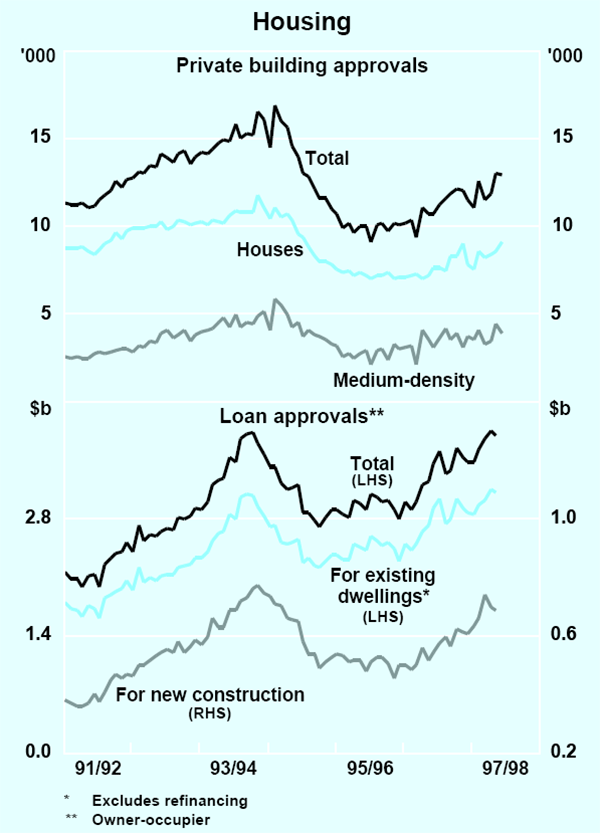
The business sector
Recent surveys of business sentiment suggest an improvement in trading conditions since the first half of 1997, which is consistent with the pick-up in consumer spending and the gradual impact of the trend towards lower interest rates from the middle of 1996. This is apparent across a range of surveys, including the National Australia Bank survey of firms across the whole non-farm economy, the Yellow Pages survey of small businesses, the ACCI-Westpac survey of manufacturing and the Dun and Bradstreet survey of manufacturing, retailing and wholesaling (Graph 12).
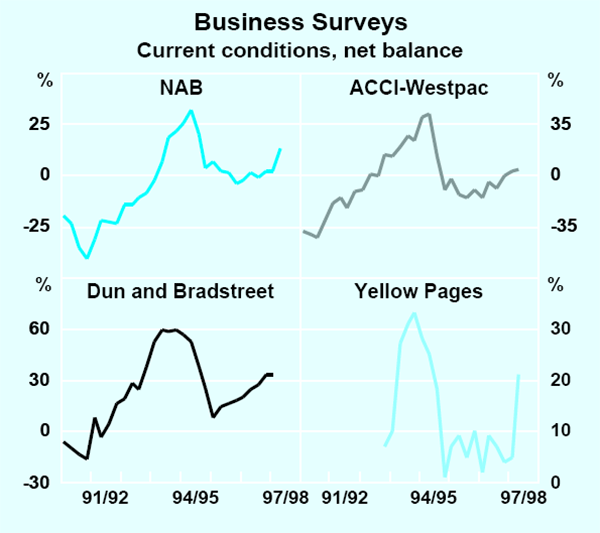
Although trading conditions are reported to be improving, firms continue to operate in a competitive environment in which they have only limited capacity to raise selling prices. This is shown by low rates of increase in output prices and subdued corporate profit growth. Adjusting for privatisations, profits in the private corporate sector as a ratio to GDP have been around their longer-term averages for the past few years with, if anything, a slight tendency to decline. In the September quarter of 1997, corporate profits amounted to 14.3 per cent of GDP, about ½ a percentage point below the decade average.
While indicators of current domestic conditions remain strong, there has been a recent tendency for businesses to note a weakening in export sales and to expect a weakening in future conditions. This seems to reflect concern about the impact of the Asian financial problems: surveys that have questioned Australian firms about the likely impact of Asian instability on trading conditions have reported an increase in concern in the December quarter.
Private business investment remains strong. Over the year to the September quarter 1997, business fixed investment grew by 15 per cent, its fifth year of double-digit growth. The strong performance over the past year was entirely accounted for by growth in equipment investment; by contrast, investment in building and structures declined slightly. The latest ABS Capital Expenditure Survey suggests further strong growth in equipment investment in the 1997–98 financial year, with the fourth estimate of investment intentions for 1997–98 showing a significant upgrading compared with the previous three estimates (Graph 13).
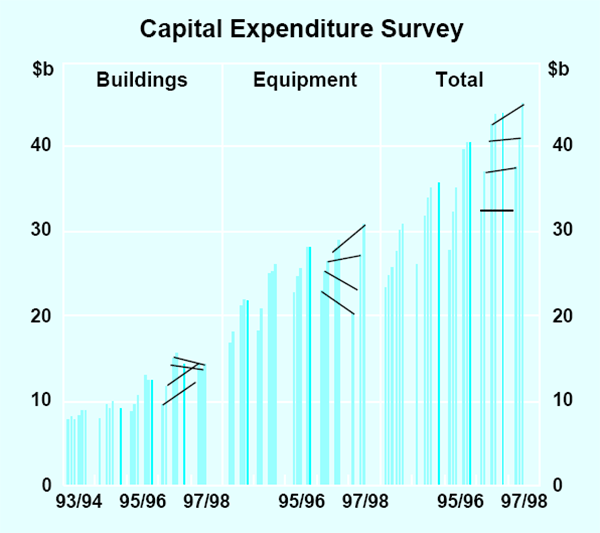
Forward indicators of investment in buildings and structures are more mixed. The Capital Expenditure Survey suggests that there will be little, if any, growth in this component of investment in 1997–98, while other indicators suggest a stronger outlook. The stock of work yet to be done on non-residential buildings in the ABS Survey of Building Activity has been rising solidly over recent years (Graph 14). Furthermore, the pick-up in non-residential building approvals in the second half of 1997 is indicative of a strengthening in activity in this sector over coming quarters. In the engineering construction sector, a large stock of work yet to be done has been built up recently, concentrated mainly in private-sector infrastructure (mainly road building) and mining projects. Together, these other indicators suggest that buildings and structures investment may not be as weak as suggested by the Capital Expenditure Survey.
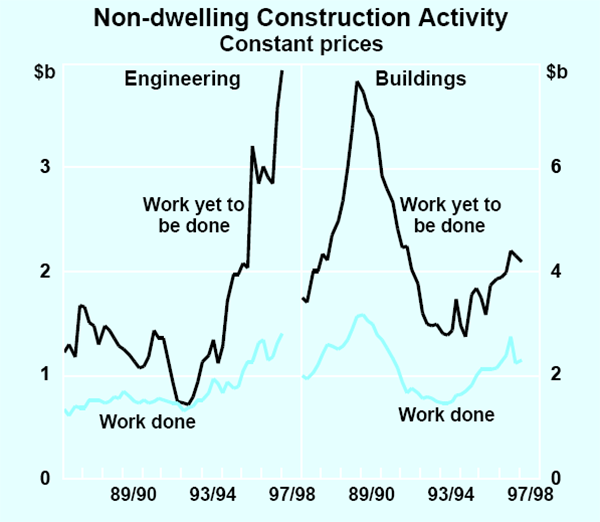
In terms of the sectoral pattern of investment, most of the expected growth in investment in 1997–98 is in the mining industry. If the latest survey expectations are realised (and the fourth estimate usually gives quite a good guide to actual investment) investment expenditure in the mining industry this financial year will exceed that in the manufacturing industry for the first year since these data became available in 1963. This is partly a consequence of the subdued nature of the manufacturing sector, with squeezed profitability and weak output growth over the past few years. Expected growth in mining investment is nevertheless very strong: if expectations are realised, investment expenditure in mining this financial year will be almost twice that of three years ago.
Investment expectations are, however, subject to the unavoidable uncertainties arising from the economic problems in Asia. The latest estimates of investment are based on a survey of firms conducted in October and early November 1997, when the economic problems of South-East Asia were apparent, but those of North Asia were less so. It remains to be seen whether some investment projects are postponed on account of these problems.
For the mining sector, there is evidence that confidence about the future is waning, which might in time be expected to reduce future investment. A comparison of the latest quarterly NAB survey (conducted in late November and early December 1997) with the one conducted three months earlier, reveals that mining firms have sharply downgraded their expectations of business conditions over the next 12 months (in contrast to firms in other sectors which report only a minor downgrading). This also seems consistent with the stockmarket's valuation of mining companies, with the All Resources Index falling by one-quarter over the second half of 1997, compared with a fall of less than 5 per cent in the All Ordinaries Index over this time.
No doubt part of this weakness reflects the decline in global commodity prices over recent months and the fact that many Australian mining companies are global in their operations. So far as mining activity in Australia is concerned, however, the fact that the prices of commodities measured in Australian dollars have tended to rise as the Australian dollar has depreciated against major currencies (see below), should help to support longer-term profitability and confidence in the mining sector.
Commodity prices
Commodity prices have declined in recent months, with developments in Asia expected to contribute to some weakening in world demand for commodities in 1998 (Graph 15). The Bank's commodity price index in SDRs has declined by 6 per cent since September 1997, bringing it back to the levels of late 1995. However, the depreciation of the $A against the major world currencies has meant that Australian dollar prices received by domestic commodity producers rose through most of 1997.
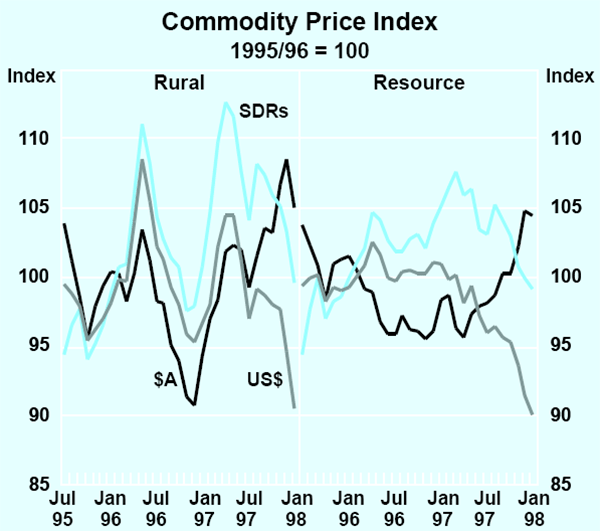
Base metal prices in US dollars have fallen by almost 20 per cent in the past six months, undoing almost all of their rise over the previous year. They are now moderately below their average of the 1990s, with continued good demand from Europe and the US offsetting, to some extent, the worsening prospects in Asia. This has also been a factor in the 3 per cent rise in $US contract prices negotiated for iron ore exports in 1998, despite an expected slowing in steel production throughout Asia and the strength of the US dollar against most of the world's currencies.
This worldwide strength of the US dollar goes some way to explaining the fall in the US dollar prices of other key commodities. The US dollar contract prices of Australia's coal exports will be reduced in 1998, with falls of between 5 and 10 per cent beginning in April. However, since January 1997 (when these contracts were last negotiated), the US dollar has appreciated by 13 per cent against the Australian dollar, meaning that coal contract prices have risen in Australian dollar terms over this time. Gold prices have been declining in US dollar terms, but are little changed in Australian dollars since the middle of 1997. Crude oil prices have been weaker, falling by around 20 per cent in US dollars since October.
There have also been noticeable falls in rural prices. Wheat prices in US dollars have continued to ease, with world production boosted by large harvests in Europe and the US, although again, measured in Australian dollars, they have been largely unchanged since the beginning of 1997. Since November, the price of wool has fallen by more than 10 per cent in $A terms, despite the currency depreciation, as demand from Asia is expected to weaken in 1998.
The external sector
After being in surplus for most of 1997, the balance of trade in goods and services moved into deficit at the end of the year. This mainly reflected a 12 per cent increase in imports in December. The volume of exports grew strongly over the year, boosted by strength in resource exports, especially metals (Graph 16). Despite some quarterly volatility, the volume of manufactured exports also increased, rising by around 10 per cent over the year to December. By contrast, rural exports have begun to weaken, no doubt reflecting the drop in farm output in 1997–98 following last year's record harvests.

There have been tentative signs of a weakening of Australian exports to East Asia in recent months, although it is too early yet for these to have become widespread. In broad terms, exports to East Asia were flat during 1996, but began to recover quite strongly in the early part of 1997, following the pattern of East Asia's aggregate international trade. The latest monthly data, although volatile, suggest that the stronger growth in exports to the region continued for most of 1997, but that exports in some areas, particularly to the ASEAN-4 countries, declined at the end of the year (Graph 17). There have also been some substantial declines in tourist arrivals from a number of countries in the region (Graph 18).
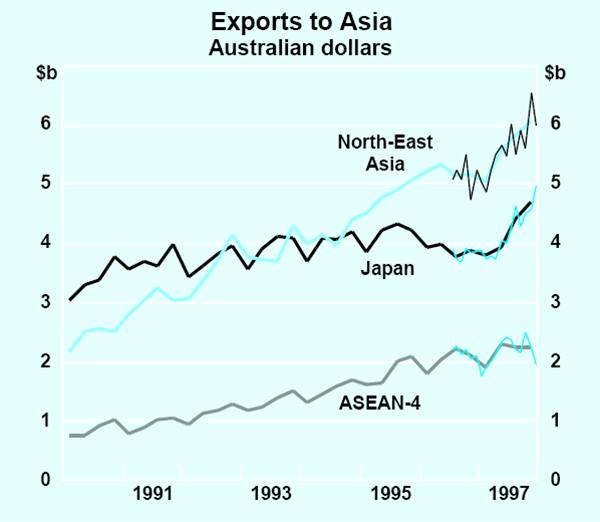
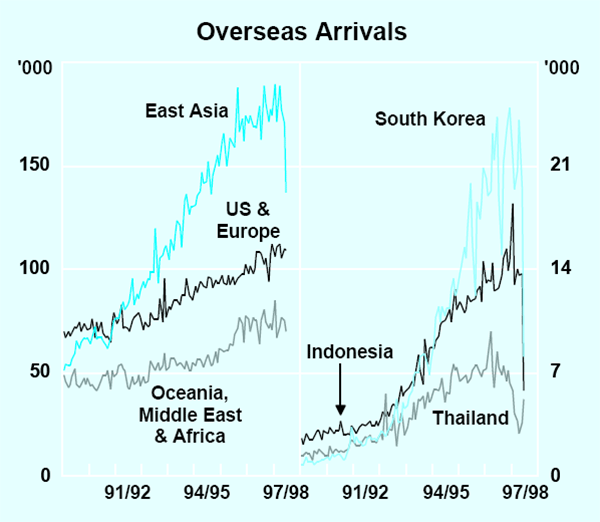
A weaker export performance has been most clearly evident in the case of Thailand, which was the first of the East Asian economies to turn down. Australia's merchandise exports to Thailand have been declining for much of the past two years. More recently, there has been a significant weakening in merchandise export sales to Indonesia. Visitor arrivals from both Thailand and Indonesia have also fallen sharply since mid 1997. In December, arrivals from Thailand were nearly 40 per cent below their level of a year earlier, and those from Indonesia over 50 per cent lower.
Exports to Japan have so far been resilient in the face of weaker Japanese growth, although the strength of exports in Australian dollar terms may partly reflect valuation effects. Visitor arrivals from Japan have fallen by over 10 per cent over the year to December. Total exports to Korea have declined by close to 20 per cent over the past year, but this picture is significantly affected by exports of gold. Gold had been a major area of growth in exports to Korea in recent years (rising to 40 per cent of the total in 1996), with much of the gold apparently being imported by Korea for re-export. This activity has recently contracted. Gold, however, is a commodity for which alternative markets can be found at prevailing world prices, and the decline in gold exports to Korea since mid 1997 has been matched by a rise in gold exports to Hong Kong and Singapore. Excluding gold, Australia's merchandise exports to Korea have been flat in Australian dollar terms over the past year. Visitor arrivals from Korea, however, fell sharply in December to be over 60 per cent lower than a year earlier.
Buoyant domestic demand in Australia continues to drive strong growth in imports. The quantity of imports is estimated to have risen by about 3 per cent in the December quarter, mostly accounted for by a strong rise in the month of December. Growth was concentrated in capital goods and intermediate products. A pause in consumer imports followed exceptionally strong growth (around 15 per cent) over the previous two quarters.
The current account deficit has remained close to 4 per cent of GDP over the past couple of years, with rising terms of trade offsetting the effect of faster growth in the quantity of imports. Over the course of 1998, however, the combined impact of the recent decline in the world price of commodities, slower trading partner growth acting to restrain export volumes, and continued strong domestic demand is likely to lead to a noticeable widening in the current account deficit.
Australian net foreign debt, at 42 per cent of GDP in the September quarter of 1997 (the latest available data), was roughly the same as it has been over the past few years. This relative stability has been a consequence of both the longer-term improvement in the trade account and the shift towards equity financing of the current account over this time. Approximately 40 per cent of the foreign debt is denominated in Australian dollars, providing some insulation from the effects of exchange rate movements.
Labour market
Employment picked up strongly in the second half of 1997, after a period of lacklustre growth (Graph 19). Total employment grew at an annual rate of almost 3 per cent in the second half of 1997. Full-time employment rose faster, at an annual rate of 3½ per cent, after recording no net growth over the previous 18 months (Graph 20).
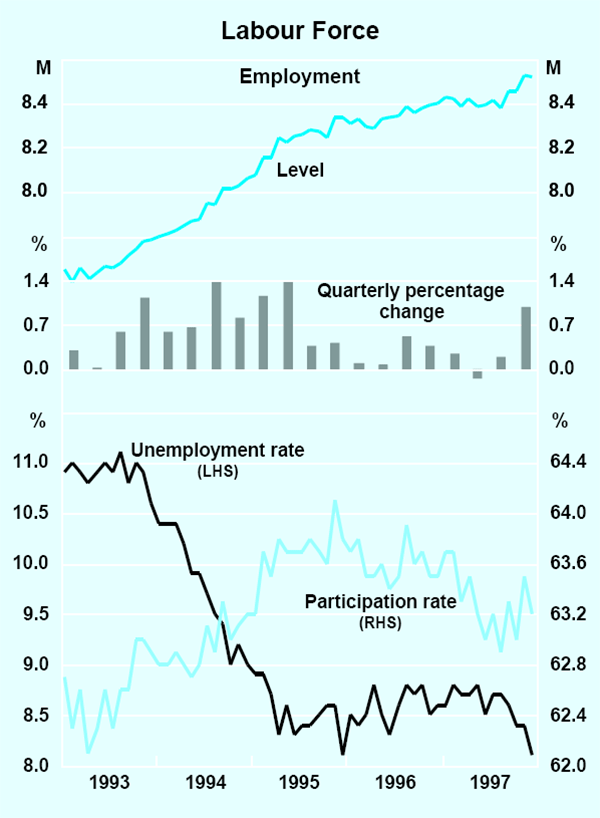
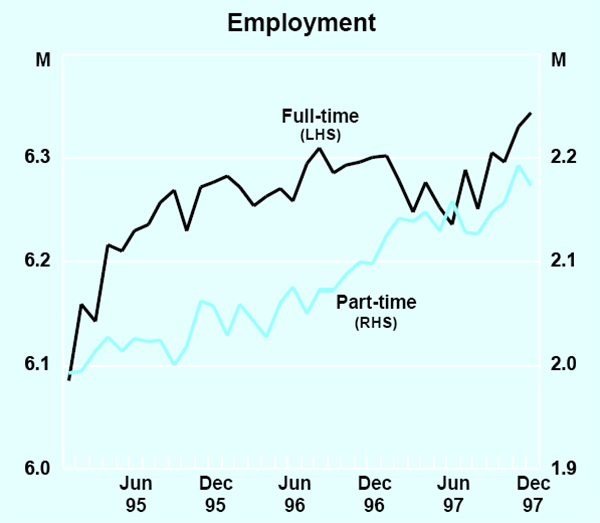
An alternative way of calculating employment growth (based on a matched sample of the roughly seven-eighths of people common to the survey in successive months) suggests that the extent of both the earlier weakness and the subsequent strength of the pick-up may have been exaggerated by the published estimates. (Further details on calculation of the matched-sample estimates are provided in the November 1997 Semi-Annual Statement on Monetary Policy.) Taking the two series together, however, gives a clear indication of a firming in the labour market in the second half of 1997.
This assessment is supported by the recent behaviour of the participation rate (the proportion of the working age population that is either employed or actively looking for work). This had declined gradually from mid 1995 to mid 1997, in line with the sluggish growth of employment. The decline in the rate was particularly sharp for 15–24 year olds, which is consistent with a faster-than-usual rise in the proportion of this age group undertaking education over this time. In the second half of 1997, however, as employment strengthened, the participation rate turned up as people were encouraged back into the labour force. In addition, the unemployment rate began to decline. It reached 8.1 per cent in December and averaged 8.3 per cent in the December quarter, after averaging 8.7 per cent in each of the preceding three quarters.
These trends are mainly a result of the pick-up in growth in the economy observed over the past several quarters. Consistent with this, the observed strengthening in employment has been concentrated in wholesale and retail trade and construction – industries that are generally thought to be sensitive to the state of the business cycle. Over the three months to November, these cyclically sensitive industries generated net jobs growth of 114,200. Agriculture, and to a lesser extent mining, also contributed to employment growth. By contrast, employment in manufacturing remains stagnant, consistent with subdued profits and modest output growth, as well as strong real wage growth in significant parts of the industry.
Most forward-looking indicators suggest that the demand for labour will continue to strengthen in the months ahead. According to the ABS data, the number of private-sector job vacancies increased by 6.8 per cent over the year to November 1997, continuing the modest upward trend evident over the past two years. The ANZ measure of job vacancies declined in January 1998, but remains 13 per cent higher than a year earlier. Business surveys of hiring intentions present a more subdued outlook, particularly for manufacturing firms, the majority of which say that they intend to continue shedding labour.
Financial aggregates
The pace of financial intermediation in the economy appears to have picked up as domestic economic activity has accelerated. The stock of credit outstanding from financial intermediaries to the non-finance sector grew at an annual rate of 13.1 per cent over the six months to December 1997, with much of the pick-up occurring in the last three months of the year. This represents a rapid pace of growth in an economy in which nominal output is likely to have grown at an annual rate of something like 5 per cent over the same period. The pick-up in credit growth occurred in both the personal and business sectors (Graph 21).
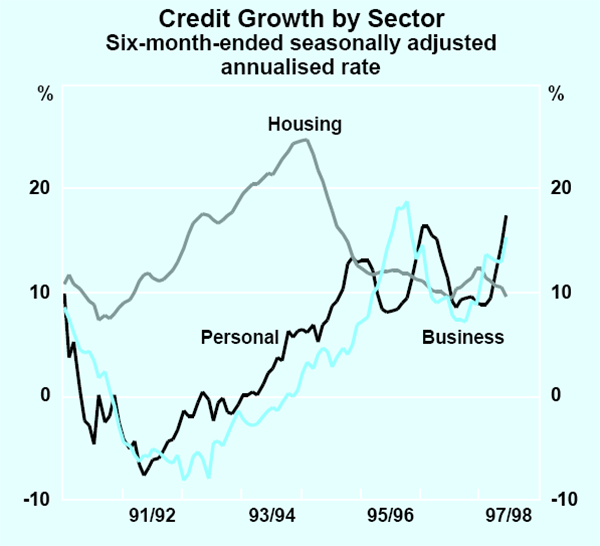
On the other side of intermediaries' balance sheets, growth in broad money eased towards the end of 1997, after running at double-digit annual rates earlier in the year. Consistent with the reduced opportunity cost of holding transaction accounts and cash in an environment of low inflation and low market interest rates, M1 remains the fastest-growing monetary aggregate, although the growth rates seen in recent months have also fallen well below those in the first half of 1997. This suggests that the portfolio adjustment to the low interest rate environment may have largely run its course. Currency growth also slowed a little towards the end of last year. Nevertheless, it remained stronger in 1997 than at any time since the early 1990s; currency grew by 7.5 per cent over the year to December, more than double its rate of growth a year ago. In the last few months of 1997, it is likely that the Telstra float and the purchase of the second instalment of the third tranche of Commonwealth Bank shares have led to a modest boost to credit and a modest slowing of monetary growth, as people borrowed and drew down deposits to pay for shares, with the proceeds flowing out of the private financial sector to the Commonwealth.
| Six months to: | Three months to: | ||||
|---|---|---|---|---|---|
| June 1997 | December 1997 | September 1997 | December 1997 | ||
| Total credit | 10.1 | 13.1 | 11.9 | 14.3 | |
| – Personal | 8.9 | 17.4 | 12.2 | 22.8 | |
| – Housing | 12.2 | 9.6 | 9.2 | 9.9 | |
| – Business | 8.8 | 15.3 | 14.7 | 15.8 | |
| Currency | 7.6 | 7.4 | 6.0 | 8.8 | |
| M1 | 19.6 | 11.3 | 16.4 | 6.5 | |
| Broad money | 11.3 | 5.0 | 6.2 | 3.7 | |
Financial conditions in the household and business sectors
The easing of financial conditions, as measured by the cost and availability of credit, has been more pronounced for household borrowers than for other sectors over the past 18 months. This is because of the increased competition between established providers and new entrants into the home-loan market, which has, to date, seen standard variable home-loan rates fall by more than other interest rates. As a consequence, home-loan rates in real terms are now well below their previous lows registered in 1993–94, when the economy was still emerging tentatively from the downturn of the early 1990s.
The fall in home-loan interest rates represents a boost to the disposable incomes of many of the nearly 30 per cent of households with home loans. One response to this rise in incomes has been the renewed strength of private consumption during 1997. But many households have also taken the opportunity presented by the fall in home-loan interest rates to increase the equity in their homes, by maintaining monthly repayments at their old level and hence reducing the principal more quickly than required under the original terms of their loans. This is likely to explain the moderate growth in housing credit since mid 1997, despite very high levels of new housing loan approvals.
Coincident with the strength in private consumption, personal credit growth picked up significantly in the second half of 1997. Part of the strength, particularly in October and November, appears to reflect greater use of credit by small investors participating in the Telstra share float. Overall, commitments for new personal lending have been rising sharply, and this has been reflected in consumption and personal credit outstanding. Rapid growth in personal credit in December reflects strength in the revolving components of personal credit, particularly bank overdrafts, which increased strongly in the last three months of 1997 and remains the fastest growing component of personal credit.
The business sector remains well-placed to fund investment despite some softness in profits and retained earnings. Business credit has picked up noticeably in recent months, with annualised growth of 15.3 per cent in the six months to December 1997, compared with 8.8 per cent in the previous six months, although part of this acceleration reflects new loans to finance the purchase of recently privatised businesses. Funding from raisings of new equity has also increased of late. Taking these two funding sources together with retained earnings, total business funding (adjusted for privatisations) has risen through 1997 to 15.2 per cent of GDP in the September quarter, above its decade average of 13½ per cent.
On 1 January 1998, the AMP Society was demutualised with the issue of shares to its 1.8 million policyholders. The new controlling company, AMP Limited, is scheduled to be listed on the stock exchange around the middle of the year, with estimates of market capitalisation in the region of $9½-11 billion. Shares were allocated to policyholders on the basis of the size of their policies, the extent of their participation and the length of time for which they had been held. The demutualisation gives current policyholders (who are now shareholders) a readily transferable share of the wealth that has accumulated in the AMP Society since itsn inception. In that sense, the demutualisation may be seen as a windfall gain by current policyholders/shareholders. Experience with demutualisations in other countries, mainly the UK, suggests that some shareholders are likely to respond by increasing their expenditure, providing a boost to aggregate demand during 1998.
Intermediaries' interest rates
There has been no movement for some time in the indicator rates on variable-rate housing loans or on loans to small and large businesses. Housing rates remain at 6.7 per cent from banks and 6.4 per cent from mortgage managers, while indicator rates for variable-rate loans are 8.8 per cent for small businesses and 8.5 per cent for large businesses. In the case of business loans, these are the lowest rates since 1973; in the case of housing loans the rate is lower than at any time since 1970 (Graph 22).
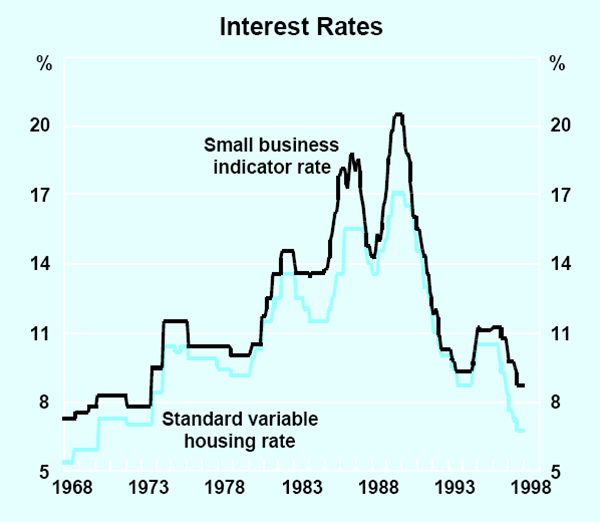
Despite the steadiness in standard indicator rates, the average interest rate paid by small businesses is continuing to decline, partly because banks have become more innovative in the loan products offered to this group. Each quarter, the Bank collects information on the total cost of loans to businesses. In the latest collection, for the September quarter 1997, the interest cost of variable-rate borrowing by small business fell by 1.0 percentage point to 9.6 per cent. This brought the total fall since mid 1996 to 3.0 percentage points, less than the 3.8 percentage point fall in the standard variable home-loan rate, but 0.5 of a percentage point more than the cut in the cash rate over this period. This suggests that competitive forces have now spread more widely, from the market for housing loans into the provision of small business financing. This is partly because reduced margins on housing lending have forced banks to look to increase market share in other sectors. Consequently, banks have introduced a number of new lending products for small businesses. These facilities are at discounted interest rates and better reflect the type of security small businesses have to offer. In particular, each of the major banks introduced a residential-secured product early in 1997, which enables small businesses to borrow at a variable rate, close to that on housing loans, with no customer risk margin.
In line with interest rates in capital markets – where fixed-rate loans are funded – indicator rates on fixed-rate loans have fallen further in recent months. The average interest rate on a fixed-rate housing loan with a term of three years has fallen by 0.6 of a percentage point to 6.7 per cent since the last cut in the cash rate in July, including a round of reductions by a number of banks in January. Since their recent peak in June 1996, these rates have fallen by 2.9 percentage points. In addition to these carded rates, several banks made available ‘special offers’ for fixed-rate housing finance during January. In January, the indicator rate on fixed-rate loans for business for a term of three years was 7.2 per cent, 0.2 of a percentage point lower than in July 1997.
The average interest rate actually paid on all outstanding fixed-rate loans has fallen by less than the relevant indicator rate. In the September quarter, the average interest rate on outstanding fixed-rate loans to small business fell by 0.4 of a percentage point, to 9.4 per cent; since the June quarter 1996, this rate has fallen by 1.2 percentage points, compared with a fall in corresponding indicator rates of 2.8 percentage points. The reason the fall in the average interest rate on outstanding fixed-rate loans is smaller than the fall in the indicator rate is that lower indicator rates have not worked their way through the stock of outstanding fixed-rate loans and will not do so completely until that stock is fully rolled over.
The total weighted average interest rate on all small business loans (fixed and variable) fell by 0.7 of a percentage point in the September quarter 1997 to 9.3 per cent, 2.1 percentage points lower than in the June quarter of 1996.
Inflation Trends and Prospects
Recent developments in inflation
Consumer prices in underlying terms rose by 0.3 per cent in the December quarter 1997, to be up by 1.4 per cent over the year. Annual underlying inflation has now fallen steadily from its most recent peak of 3.3 per cent in the March quarter of 1996 to its current rate, which is the lowest since the series began in the early 1970s (Graph 23).
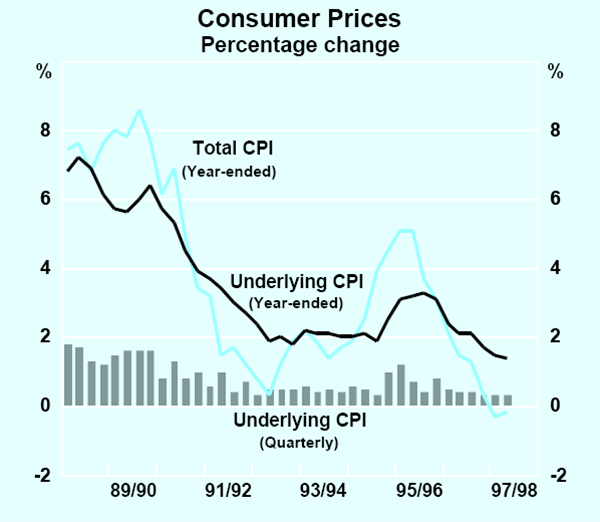
The headline CPI also rose by 0.3 per cent in the quarter, but was 0.2 per cent lower than a year ago. Falls in mortgage interest rates continue to reduce the headline series, detracting 0.3 of a percentage point in the December quarter 1997 and around 1¾ percentage points over the year. This effect on the headline CPI was offset in the quarter by increased health costs and higher prices for tobacco and selected food items.
The prices of domestically produced consumer goods rose by 0.6 per cent in the December quarter, and by 1.7 per cent over the year, continuing the gradual slowing in growth evident in recent quarters (Graph 24). In the private sector, goods prices continue to rise considerably more slowly than services prices. Private-sector goods prices rose by only 0.7 per cent over the course of 1997, compared with a rise in the prices of private-sector services (which exclude interest charges) of 3.3 per cent. The price of imported consumer goods fell by 1.2 per cent in the quarter and by 2.6 per cent over the year – its largest annual fall on record. The biggest falls were for imported motor vehicles, but the prices of many other types of imported consumer goods also fell.
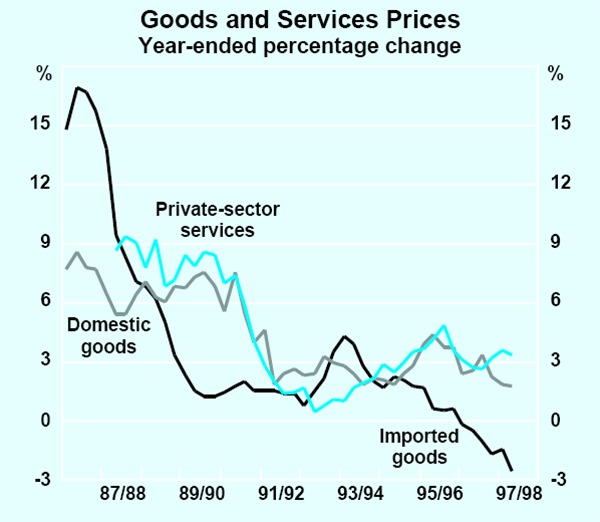
The continuing falls in the prices of imported consumer goods are largely a consequence of the appreciation of the Australian dollar early in 1996 and the maintenance of that higher level for most of 1997. In October 1997, however, the currency depreciated sharply in import-weighted terms, with the depreciation not being reversed until late January 1998. This had an immediate impact on both imported prices over the docks and imported producer prices (Graphs 25 and 26). The import price index rose by 4.2 per cent in the quarter, its largest quarterly rise in 11 years, to be up by 6.4 per cent over the year. Very similar prices rises, 4.0 per cent over the quarter and 6.3 per cent over the year, were recorded by imported final manufactured goods. That prices of imported products at the retail level fell in the December quarter reflects the fact that there are normally long lags in the pass-through of exchange rate movements to final retail prices. With the unwinding in January 1998 of the late 1997 currency depreciation, the sharp rises in over-the-docks import prices in the December quarter should be expected to have only limited impact on consumer prices. (See the later section, Inflation outlook, for a discussion of the import-weighted and trade-weighted measures of the currency.)
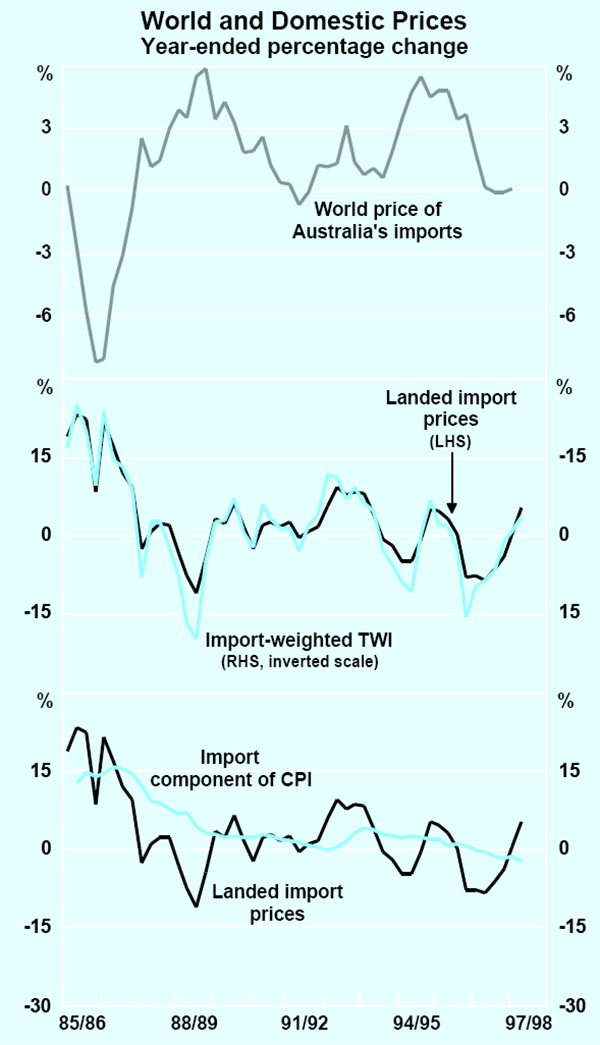

The prices of domestic inputs have been picking up gradually for much of the past year. Over the year to the December quarter 1997, the price of domestic raw material inputs (including petroleum) rose by 2.0 per cent, while domestic intermediate goods prices rose by 2.4 per cent, in both cases the largest annual rises for two years. Reflecting this pick-up in input costs, domestically produced manufacturing prices have also edged up, rising by 0.5 per cent in the December quarter of 1997 and by 1.5 per cent over the year, also their highest annual rate for two years.
The ABS announced in November 1997 that it will replace the current CPI with an acquisitions-based CPI, which will exclude interest charges for mortgages and consumer credit. The price of home ownership will be measured by net expenditure on new dwellings (excluding land). A new group, Financial Services, will be incorporated in the index, as will the prices of some additional items that are forming a rising share of consumer spending (computers, tertiary education fees and domestic services). These changes will be introduced from the September quarter 1998.
Trends in labour costs
The latest available data on earnings growth showed average weekly ordinary-time earnings (AWOTE) increasing by 4.4 per cent over the year to August 1997 (Graph 27). This figure has been affected by some marked volatility in the quarterly movements, with AWOTE increasing by 1.9 per cent in the three months to August but only 0.3 per cent in the previous three months.

There has for some time been a marked divergence between public- and private-sector components of wage growth, although more recently the two have begun to move closer together. Measured growth in public-sector AWOTE slowed to an annual rate of 6.1 per cent over the year to August, from a rate of 7.2 per cent the previous quarter. However, this remains higher than other indicators, particularly the enterprise bargaining data, would suggest. It is likely that aggregate public-sector earnings growth continues to be affected by compositional change within the sector, which contributes to some overstatement of the increase in wage rates.
In the private sector, AWOTE increased by 2.0 per cent in the three months to August, to be up by 4.0 per cent over the year. This compares with an estimated fall of 0.1 per cent in the three months to May, implying a rise of 2.5 per cent over the year to May. These quarterly numbers are, however, subject to a good deal of unavoidable statistical noise (driven partly by changes in the sample of firms from one survey to the next). The rise in the estimated annual growth of private-sector AWOTE from 2.5 per cent to 4.0 per cent probably owes more to this noise than to an underlying pick-up in private-sector wage growth. The former number probably understates private-sector wage growth, while the latter probably overstates it.
While there remains considerable uncertainty, annual wage growth (allowing for some over-statement in the public-sector AWOTE numbers) appears to be running at about 4 per cent, with the private-sector component probably somewhat lower. Wage growth at these rates does not represent a threat to the inflation target. From the perspective of employment, however, rates of wage growth over much of the past couple of years have been on the high side for an economy with very low inflation and an unemployment rate over 8 per cent.
The latest data on wage rises negotiated under enterprise agreements, covering the September quarter 1997, continue to show average annual outcomes in the 4½–5 per cent range, as they have done for some time (Graph 28). Some moderation of wage outcomes from private-sector enterprise agreements appears to have been occurring over recent quarters; new federal agreements registered in the September quarter 1997 yielded average annual increases of 4.4 per cent, compared with a revised 4.8 per cent in the previous quarter and over 5 per cent for much of 1996. There remains much diversity between outcomes, but there are also indications that some major private-sector agreements are being renewed at lower rates. In the finance sector, re-negotiated agreements at the larger banks are yielding annualised wage increases in the 3 to 4 per cent range (adjusting for the time since the expiry of previous agreements), down from 5½–6 per cent in previous agreements. In the public sector, some agreements during the first three quarters of 1997 yielded relatively high increases, but more recent indications are that agreements currently being renewed are in the 3 to 4 per cent range. Executive salaries, according to the Cullen Egan Dell survey, recorded their largest quarterly rise for more than seven years in the December quarter, returning the annual rate of growth to over 6 per cent.
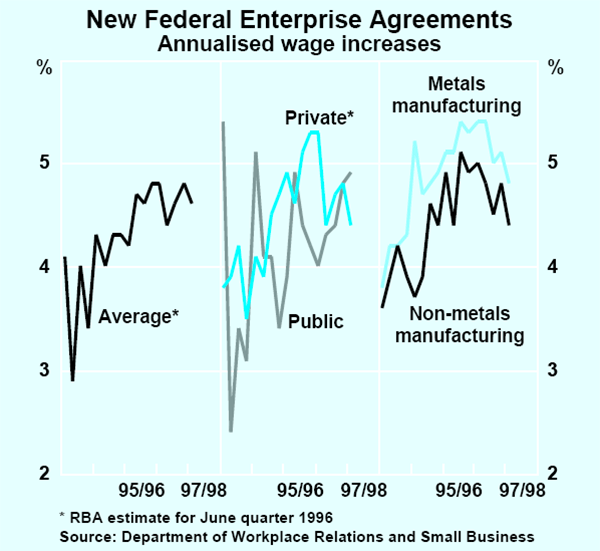
By now, nearly all of the $10 per week increase in safety-net payments approved by the Australian Industrial Relations Commission in April 1997 should have been paid to workers on awards. The Commission will now consider a claim by the ACTU for a flat dollar increase of $20.60 in all award wages, and a further $38 increase in the following year.
Inflation expectations
Most measures of inflation expectations remain close to their historical lows following significant declines in late 1996 and into 1997. Nevertheless, consumers' and businesses' expectations of inflation over the medium term remain above the Bank's target. Expectations of financial market participants, by contrast, are consistent with the target, as has been the case for some time.
Consumer inflation expectations, as measured by the Melbourne Institute survey, after taking a clear downward step in late 1996, have mostly fluctuated in the 3–3 ½ per cent range since then (Graph 29). In the January 1998 survey, however, the median expectation of inflation over the year ahead picked up to 3.6 per cent, from 3.1 per cent in December 1997, and above its average since late 1996. This pick-up may reflect consumers' perceptions of the implications of the exchange rate depreciation occurring around that time, since the majority of respondents reported hearing news about currency movements.
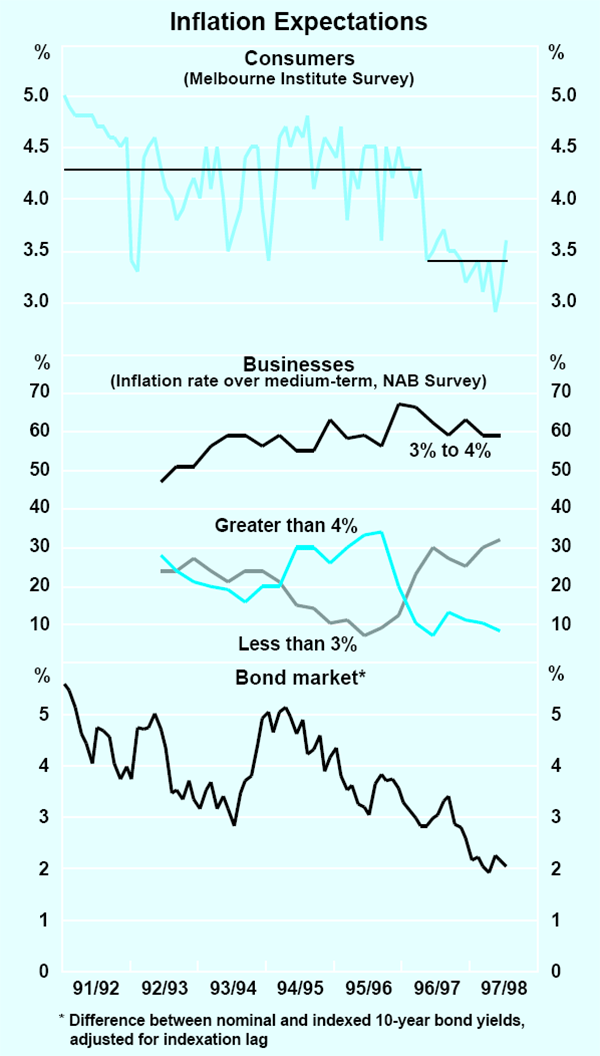
Near-term expectations of business selling prices remain subdued. The average expected rise in retail selling prices for the March quarter 1998 is 0.4 per cent in both the ABS and NAB surveys, similar to expectations in recent quarters. In the latest ACCI-Westpac and ACM surveys of the manufacturing sector, there have been small falls in the net balance of respondents expecting to raise selling prices.
Longer-term inflation expectations, as recorded in the latest NAB survey, have been generally steady, with most respondents continuing to nominate 3–4 per cent as the range in which inflation is most likely to be maintained over the next five to ten years. There has, however, been a gradual rise over time in the proportion of businesses expecting inflation to be maintained below 3 per cent and a corresponding fall in the proportion expecting it to be above 4 per cent over this period. Inflation expectations of participants in financial markets continue to be lower than those of consumers or businesses. The Bank's survey of financial market economists, taken just after release of the December quarter CPI figure, obtained a median forecast for underlying inflation over the year to June 1998 of 1.8 per cent, a slight decline from the previous reading. The forecast for the year to June 1999 increased slightly, from 2.6 to 2.7 per cent. On the latest readings, the indexed bond yield differential, a measure of longer-term market expectations, was implying an average inflation expectation of slightly above 2 per cent.
Inflation outlook
Annual inflation in underlying terms probably reached its trough in the December quarter of 1997. The Bank currently expects that inflation will gradually return to the 2–3 per cent target range over the year ahead. Over a slightly longer horizon, subject to some provisos, inflation should remain consistent with the target. Several factors will be at work in producing this outcome.
One element in the expected small rise in inflation over the coming year is that prices for internationally traded goods and services, which had for some time been declining as a result of the earlier appreciation in the Australian dollar, have now begun to rise following the decline in the currency in late 1997. The Australian dollar, after appreciating by about 10 per cent through 1995–96, sustained this higher level for most of 1997. In late 1997, however, it depreciated sharply against the US dollar and the major European currencies, while appreciating sharply against the currencies of East Asia. These divergent bilateral movements led to little net movement in the Australian-dollar trade-weighted index (TWI), but to a noticeable depreciation in the import-weighted index (IWI). The different behaviour of the two indices arises from the United States and Europe being relatively more important as sources for Australian imports than as destinations for Australian exports; currency movements against the US dollar and European currencies therefore have more influence on the import-weighted index than on the trade-weighted index. (See the article Alternative Measures of the Effects of Exchange Rate Movements on Competitiveness in the January Bulletin for details.)
Of the two indices, the IWI is of more relevance for inflation since import prices have a direct (although delayed) influence on consumer prices. Over the three months to mid January of 1998, the IWI was about 4 per cent below its average value for the first nine months of 1997. Past experience suggests that, other things equal, a sustained depreciation of this size would be expected to raise consumer price inflation by a little less than ½per cent over the ensuing year or so. Since mid January, however, this depreciation of the import-weighted exchange rate has been unwound, suggesting that the impetus to consumer price inflation will be quite small. Nevertheless, the extended period of declining import prices at the retail level and their restraining influence on economy-wide inflation seems to have come to an end.
A second factor is that over the past year, the economy has been expanding at a rate which is probably a little faster than its likely longer-term potential, with domestic demand in particular growing quite strongly. In the short term, this is likely to continue, and excess capacity will be gradually declining. There should be scope for this to continue for some time before serious capacity constraints are encountered. Nonetheless, as slack is wound back, there is the possibility that firms which have suffered some squeeze on profit margins over the past couple of years may seek to recoup this by raising prices at a rate ahead of the increase in their costs.
Over the medium term, developments in labour costs will, as always, be important in determining price trends. As detailed above, the Bank's assessment is that economy-wide wages growth is running at about 4 per cent on average. Non-farm labour productivity has been growing at an annual trend rate of 1.6 per cent since the beginning of the current economic expansion in mid 1991 and, over the past two years, it has grown substantially more quickly. The recent pick-up in productivity growth may partly reflect a response by employers to the stronger wage pressures in 1994 and 1995, and it is unlikely that such exceptional productivity growth will be sustained. Nonetheless, a continuation of the average rate of productivity growth for this recovery would, with current rates of wages growth, keep unit labour costs rising at an acceptably low rate.
The outlook for wages depends importantly on the strength of the labour market. With a firmer trend in employment growth, there is the possibility that labour costs might, in time, accelerate. It is too soon yet, however, to expect to see much evidence of this, particularly since the unemployment rate, while falling, remains relatively high. Some impetus to labour costs may arise from the current safety net review, depending on the AIRC's response to the claim.
A fourth factor is inflation expectations, which have declined noticeably through the past year and a half. Some increase in expectations of inflation over the year ahead has been recorded lately, but this appears to be a proportionate response to the likely short-term effects of movements in the exchange rate, rather than a more fundamental erosion of confidence in low inflation. That inflation expectations remain close to the lowest levels for a generation should be expected to play a role in keeping both wage and price aspirations to realistic levels.
A final factor which needs to be considered is the state of inflation in the rest of the world. There has been considerable attention given in some popular discussion to the possibility of global deflation arising from the Asian crisis, with the claim that a ‘global glut’ of goods sourced from Asia might precipitate a slump in prices and economic activity world wide.
At the present time, world prices for traded goods and services are broadly stable, as they have been for much of 1996 and 1997. Commodity prices have declined to some extent, after having risen in 1996 and the first half of 1997. A situation when these prices are not rising is quite common. There have been several occasions over the past 15 years when international trade prices for goods and commodities have declined. In the mid 1980s, the declines in commodity prices were much larger than they have been so far on this occasion. Nor in the bulk of the industrialised economies has there been a large, debt financed run-up in asset prices, which is the usual precondition for a sharp deflation (and has been in operation in Asia in the present episode). At the margin, however, the decline in absorption by the Asian economies can be expected to be mildly disinflationary in world markets, helping to keep inflation in Australia contained.